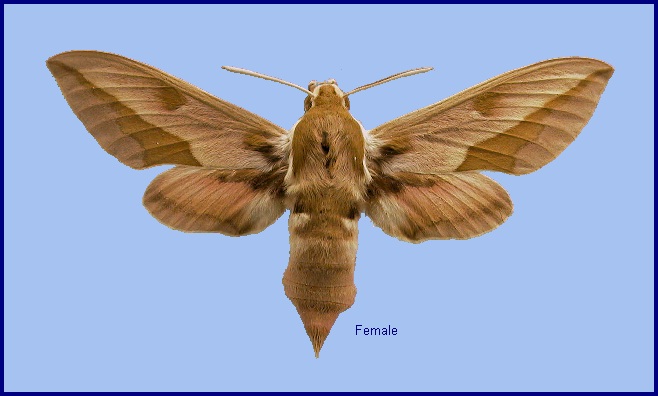
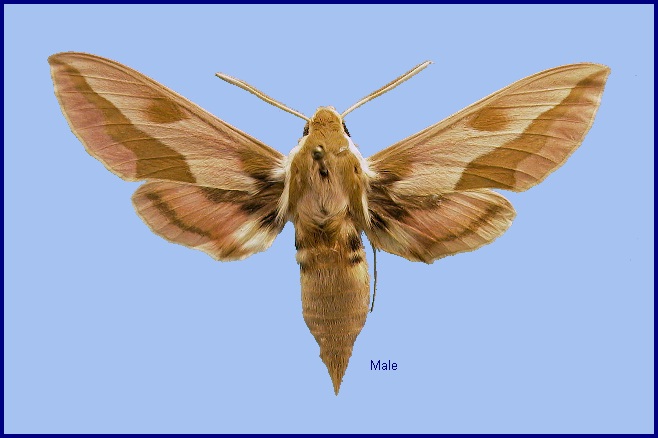
Deilephila euphorbiae var. centralasiae Staudinger, 1887, Stettin. ent. Ztg 48: 64. Type locality: [Uzbekistan,] Samarkand.
Synonym. Deilephila euphorbiae var. centralasiae Staudinger, 1887.
Synonym. Celerio centralasiae transcaspica O. Bang-Haas, 1936.
Wingspan: 60--75mm. Resembles a very pale Hyles euphorbiae euphorbiae, but the pale median stripe extends to the costa and is broken only twice, basally and centrally. First segment of foretarsus shorter than in Hyles euphorbiae, with fewer, longer spines.
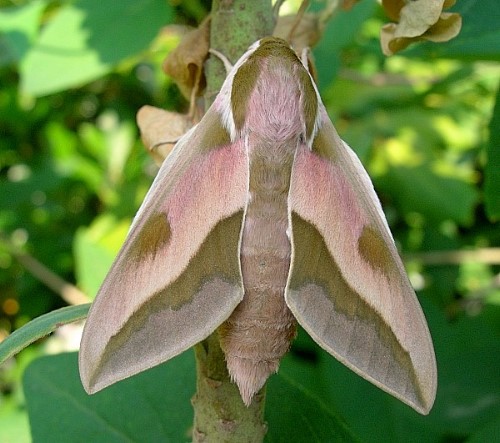
Restricted to areas where Eremurus (foxtail lily) is common on rock-strewn hill-sides; in northern Iran, usually 1000--2500m; in Turkey, slightly lower.

China: 5.v-12.vi (Shihezi); 22.v (Ürümqi); 1.viii (Shihezi). Mongolia: 18-21.v (Khovd Province); 1-2.vi. (Gov'-Altai Province).
OVUM: Very small (less than 1mm diam.), almost spherical, pale, glossy green. Laid directly on the unopened flowers (and seed-pods) of the host.
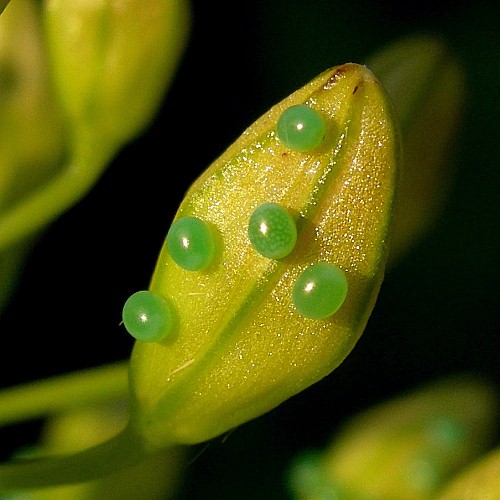
LARVA: Full-fed 70--80mm. Dimorphic: principally pale grey or off-white.
The newly-hatched 2.5mm-long larva is pale sandy-orange with a blackish brown horn (short and vertical), head, legs and shield: the body bears rows of setae of the same colour. The head and thoracic segments are tinged greenish. In the second instar the primary body colour is olive green or dark grey, with a pale yellow dorso-lateral line bearing rudimentary eye-spots, and a ventro-lateral line of the same colour. There is a hint of a red dorsal line. The third instar is similar, although the primary colour can vary from pale greyish green through greenish olive to almost black. The dorso-lateral line is more pronounced, the eye-spots pure white or white with yellow centres, and a whitish ventro-lateral line develops. The head, anal clasper and dorsal line are pale orange. In the fourth instar, the coloration ranges from pale grey to black; both forms are speckled white and bear a dorso-lateral row of round, black-ringed, startling white eye-spots. The dorso-lateral line is absent, but the ventro-lateral stripe becomes more evident, especially in the dark form. The head, legs, horn and shield are either dark brown or black.
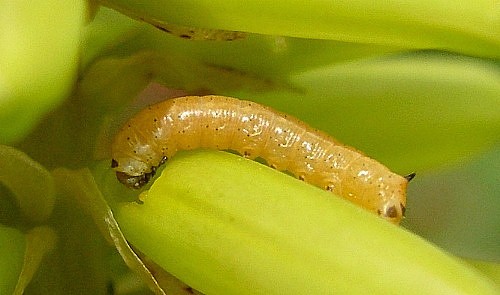
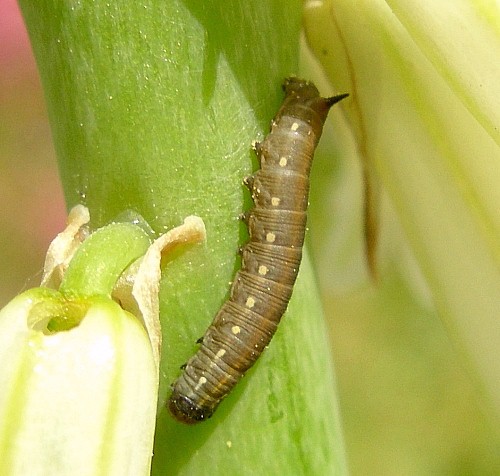
Fully grown, either pale grey or off-white, sometimes with a pale rose dorsal suffusion. Along either side a dorso-lateral line of large, brilliant white, black-ringed eye-spots. Horn, head, legs and anal flap red or black. Spiracles white, ringed with red.
Newly hatched larvae prefer the pollen-sacs of flowers and often sit on the stamens within the flower. As they grow, all parts of the flower are eaten, including the immature ovaries. Larger larvae feeds quite openly on the tall, columnar flower- and seed-spikes of the hostplant, alternating frenzied bouts of feeding with long spells of basking.
Most likely to be found in May, June, August and September. Grum-Grshimailo (1890) reported larvae to be common in southern Tajikistan during July, although he mistakenly identified them as Hyles hippophaes bienerti.
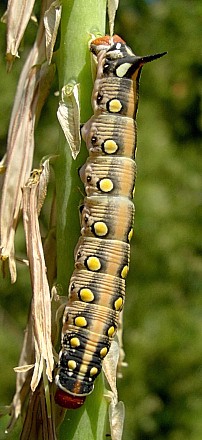
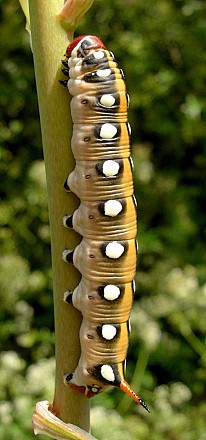
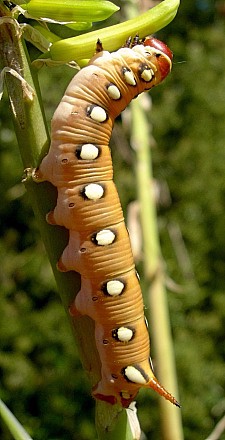
PUPA: 40--50mm. Pale brown, in a loosely spun, net-like cocoon amongst ground debris. The overwintering stage.
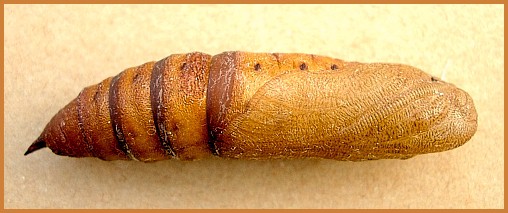
Larval hostplants. Unknown in China, but recorded on the flower and seed heads of Eremurus in Tajikistan (Shchetkin, 1960, 1975) and Afghanistan (Daniel, 1971). These records raise an intriguing biological question. If Hyles centralasiae feeds almost exclusively on Eremurus, then it cannot have a second generation on this hostplant, which flowers only in spring. However, adults have been captured in August and September, while Danner et al. (1998) noted a second generation in July. Either such individuals belong to a generation doomed to perish without reproducing, or they are part of a very late spring brood, or else Hyles centralasiae feeds on other, as yet unrecorded, autumn-flowering Asphodelaceae (e.g. Drimia (syn. Urginea)).
Unknown.
China: Xinjiang (Shihezi; Ürümqi; ?Xiaerxili Natural Reserve, near Bole City, Bortala Mongol Autonomous Prefecture).
Mongolia: Khovd Province (Bajtag-Bogd-Uul Mts., Baruun-Khargaityn-Gol (River) valley, 1900–2000m (45°16'N 90°57'E)); Gov'-Altai Province (Dzhungarian Gobi, Alag-Nuur [lake], near Ailyn-Tsagan-Khuduk, 1300m (45°09'N 94°30'E)).
From northeastern Iran, southern Turkmenistan (Danov & Pereladov, 1985; Derzhavets, 1984), mountainous eastern Uzbekistan (Shovkoon, 2010), mountainous parts of southern Kazakhstan (Danner, Eitschberger & Surholt, 1998), Tajikistan (Grum-Grshimailo, 1890; Bang-Haas, 1936) and Kyrgyzstan (Kondratiev coll., NHMUK) to northern and eastern Afghanistan (Ebert, 1969; Daniel, 1971), western Pakistan (Daniel, 1971; Rafi et al., 2014), northern Xinjiang Province, China (Pittaway & Kitching, 2000) and southwestern Mongolia (Yakovlev, Dubatolov & Titov, 2013; Yakovlev, Gus'kova, Doroshkin & Titov, 2015; Yakovlev & Doroshkin, 2017).
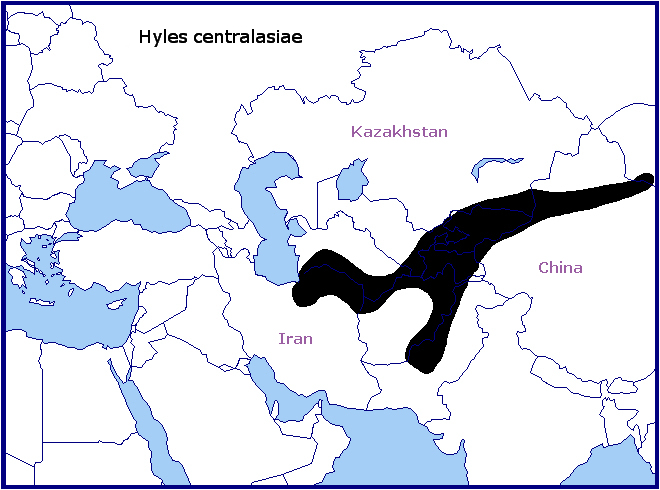
Holarctic; western Palaearctic region. Pleistocene refuge: Polycentric -- Syrian, Iranian and Turkestan refugia.
 Return to Sphingidae of the Eastern Palaearctic species list
Return to Sphingidae of the Eastern Palaearctic species list